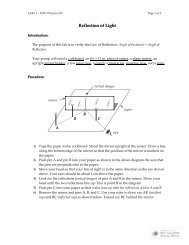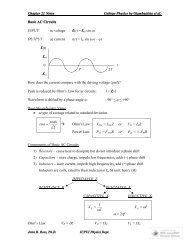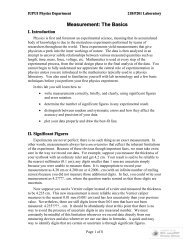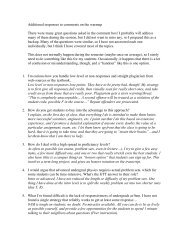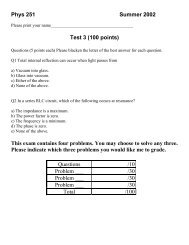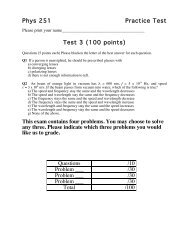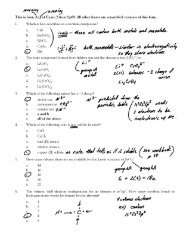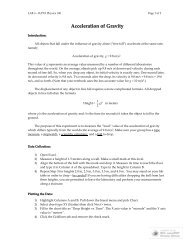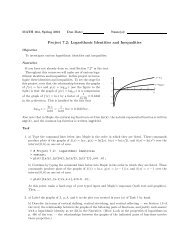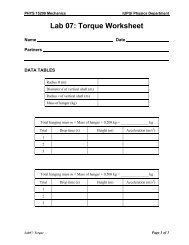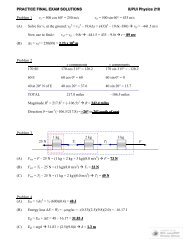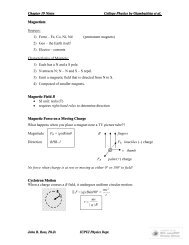You also want an ePaper? Increase the reach of your titles
YUMPU automatically turns print PDFs into web optimized ePapers that Google loves.
<strong>Phys</strong> <strong>251</strong> <strong>Sample</strong> <strong>Test</strong> 1<br />
Please print your name______________________________________<br />
Questions (5 points each) Please blacken the letter of the best answer for each question.<br />
Question 1: Positive charges of value Q = 1 nC are placed on the x-axis at the points (1,0,0) and (–<br />
1,0,0). Negative charges of value –Q are placed on the y-axis at (0,–1,0) and (0,1,0). At which of the<br />
following points is the electric field strongest?<br />
a) The origin (0,0,0)<br />
b) On the z-axis at (0,0,1)<br />
c) At the point (1,1,0)<br />
d) The field is zero at all of those points<br />
e) There is not enough information to tell<br />
Question 2: Which of the following arrangements of a battery and two identical capacitors will have<br />
the least stored energy.<br />
parallel series one capacitor not used cannot be determined<br />
from the given<br />
information<br />
This exam contains four problems. You may choose to solve any three.<br />
Please use the form below to indicate which three problems you would<br />
like us to grade.<br />
Question 1 /5<br />
Question 2 /5<br />
Problem ___ /30<br />
Problem ___ /30<br />
Problem ___ /30<br />
Total /100
Problem 1: A coaxial cable is made of two infinitely long cylindrical conductors with<br />
radii a, b, and c, as shown. The inner conductor carries a linear charge density λ. The<br />
outer conductor carries a linear charge density –λ Please determine<br />
a) The linear charge density on each surface of the outer conductor<br />
b) The electric field in each of the regions:<br />
r < a, a < r < b, b < r < c, r > c.<br />
c) The potential difference between the cylinders
Problem 2: A parallel plate air capacitor is made by using two plates 0.18 m square<br />
spaced 0.58<br />
cm apart. It is connected to a 50 V battery. Please answer each of the following questions.<br />
a) What is the capacitance?<br />
b) What is the charge on each plate?<br />
c) What is the electric field between the plates?<br />
d) If the region between the plates were filled with a dielectric material of constant<br />
K = 2.5 instead of air, what is the energy stored?
Problem 3: A small sphere of mass m, and charge +q is attached to a vertical wall by a<br />
r )<br />
massless string, as shown. An electric field E = Eoi<br />
(perpendicular to the wall) holds the<br />
sphere away from the wall.<br />
Please answer each of the following questions<br />
a) Draw a free body diagram for the sphere<br />
b) Determine the angle theta indicated in the diagram.
Problem 4: Charge Q is distributed uniformly over a thin<br />
rod of length L as shown. Please answer each of the<br />
following questions.<br />
a) What is the charge per unit length?<br />
b) What is the electric field at a point (0, y)?<br />
c) What is the electric potential at point (0,y)?<br />
(Assume the electric potential to be 0 at infinity)<br />
Note: One of the following integrals may be useful.



